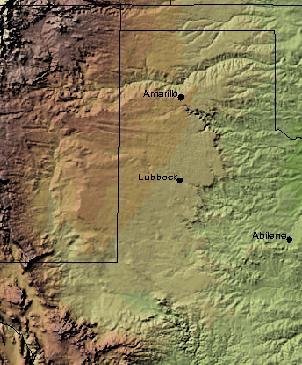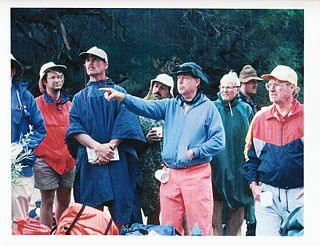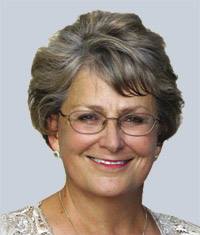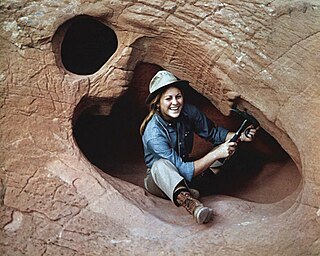Related Research Articles

The Permian Basin is a large sedimentary basin in the southwestern part of the United States. It is the highest producing oil field in the United States, producing an average of 4.2 million barrels of crude oil per day in 2019. This sedimentary basin is located in western Texas and southeastern New Mexico.

Wallace Everette Pratt (1885–1981) was a pioneer American petroleum geologist. He is also notable for helping establish Guadalupe Mountains National Park through his donation of McKittrick Canyon. He is also notable for his marriage to Iris Calderhead, prominent advocate for sex equality and his classmate from the University of Kansas, in 1931.

Texas contains a wide variety of geologic settings. The state's stratigraphy has been largely influenced by marine transgressive-regressive cycles during the Phanerozoic, with a lesser but still significant contribution from late Cenozoic tectonic activity, as well as the remnants of a Paleozoic mountain range.

Fred F. Meissner was an American geologist and engineer who contributed to the fields of geology, geophysics, engineering, petroleum engineering, geochemistry, mineralogy, physics, mining, economic geology, and fishing.

The Midland Reporter-Telegram is a daily newspaper in Midland, Texas. It is located in the heart of the vast 54-county Permian Basin of West Texas, a geological region which produces 70 percent of the oil in Texas. The newspaper's special coverage includes the "Permian Basin Oil Report", a weekly section devoted to news of the gas and oil industry, and Mywesttexasjobs.com, a weekly employment magazine that is free to the community and has a wide distribution throughout the Permian Basin.

The Spraberry Trend is a large oil field in the Permian Basin of West Texas, covering large parts of six counties, and having a total area of approximately 2,500 square miles (6,500 km2). It is named for Abner Spraberry, the Dawson County farmer who owned the land containing the 1943 discovery well. The Spraberry Trend is itself part of a larger oil-producing region known as the Spraberry-Dean Play, within the Midland Basin. Discovery and development of the field began the postwar economic boom in the nearby city of Midland in the early 1950s. The oil in the Spraberry, however, proved difficult to recover. After about three years of enthusiastic drilling, during which most of the initially promising wells showed precipitous and mysterious production declines, the area was dubbed "the world's largest unrecoverable oil reserve."
As of 2013 the Cline Shale, also referred to as the "Wolfcamp/Cline Shale", the "Lower Wolfcamp Shale", or the "Spraberry-Wolfcamp shale", or even the "Wolfberry", is a promising Pennsylvanian oil play east of Midland, Texas which underlies ten counties: Fisher, Nolan, Sterling, Coke, Glasscock, Tom Green, Howard, Mitchell, Borden and Scurry counties. Exploitation is projected to rely on hydraulic fracturing.
an organic rich shale, with Total Organic Content (TOC) of 1-8%, with silt and sand beds mixed in. It lies in a broad shelf, with minimal relief and has nice light oil of 38-42 gravity with excellent porosity of 6-12% in thickness varying 200 to 550 feet thick.
Caswell Silver was an American geologist and entrepreneur who was President of Sundance Oil Company from 1960 to 1984. In addition to the business of oil and gas exploration, he was active in the American Association of Petroleum Geologists and published original research on petroleum geology. He endowed the Caswell Silver Foundation at the University of New Mexico.

The Capitan Formation is a geologic formation found in western Texas and southeastern New Mexico. It is a fossilized reef dating to the Guadalupian Age of the Permian period.
Virginia Harriett Kline was a geologist, stratigrapher, and librarian who was heavily focused on fieldwork.
Louise Jordan was an American petroleum geologist. She received an honorary membership to the Oklahoma City Geological Society for her extensive subsurface research in the state of Oklahoma.

Alva Christine Ellisor (1892–1964) was a geologist and one of the first female stratigraphers in North America.

Slaughter Field is a 100,000+ acre conventional oil and gas field 40 miles west of Lubbock, TX in Cochran, Hockley, and Terry Counties. It was discovered in 1936 by a three-way venture between Honolulu Oil Company, Devonian Oil Company, and Cascade Petroleum Company. The area was originally two different fields: Duggan Field and Slaughter Field. When it was proven that both Duggan Field and Slaughter Field were producing from the same formation, they were combined under a single field regulation named Slaughter Field. In March 2015, it ranked 25th on the United States Energy Information's Top 100 U.S. Oil and Gas Fields.

Robbie Rice Gries is an American petroleum geologist who was the first female president (2001–02) of the American Association of Petroleum Geologists (AAPG), president of the Geological Society of America (2018–19), and founder of Priority Oil & Gas LLC. Gries is noted to have made some influential progress for women in this field. In 2017, Gries published the book titled Anomalies—Pioneering Women in Petroleum Geology: 1917-2017. Gries is recognized as an unconventional thinker when approaching geological concepts and applications.
Elizabeth Anne Elliott was a petroleum geologist. She was an active member of the American Association of Petroleum Geologists (AAPG) for 56 years, and was an elected fellow of the Geological Society of America.
Denise Cox is an American petroleum geologist and the former President of Storm Energy Ltd, an oil and gas exploration company based in Panama City, Florida. Cox is also a long-standing executive member of the American Association of Petroleum Geologists (AAPG) since joining the organization in 1984.

Randi Martinsen is an American geologist and senior lecturer in the Department of Geology and Geophysics at the University of Wyoming.
Susan Margaret Cunningham is a Canadian geologist and management figure in the global oil and gas industry. Cunningham has worked in the petroleum field since 1980, occupying various exploration and development roles within Amoco, Statoil ASA, and Noble Energy Inc. Her career has focused on the management of resource exploration projects in West Africa and the Deepwater Gulf of Mexico. Cunningham is a member of the board of directors of Chord Energy. Over the span of her career, Cunningham has been recognized for exemplary leadership ability and professional achievement by organizations not limited to the National Diversity Council and the ASME.
The Goat Seep Formation is a geologic formation found in western Texas and southeastern New Mexico. It is a fossilized reef dating to the Guadalupian Age of the Permian period.
Pinar Oya Yilmaz is a geologist known for her work in the oil and gas industry.
References
- 1 2 Reese, Donald L.; Cheatham, Bruce N. (1988). "Memorial: Mary Louise Rhodes (1916-1987)". AAPG Bulletin. 72 (1): 92–93.
- ↑ Reese, Donald L.; Cheatham, Bruce N. (1988-01-01). "Memorial: Mary Louise Rhodes (1916-1987)". 72 (1): 92–93.
{{cite journal}}: Cite journal requires|journal=(help) - ↑ "Memorial: John Emery Adams (1899-1970)". AAPG Bulletin. 55 (4): 629–631. 1971.
- ↑ Johnson, David P.; Emery Adams, John; Frenzel, Hugh N.; Rhodes, Mary Louise (1951-01-01). "Starved Pennsylvanian Midland Basin: GEOLOGICAL NOTES". AAPG Bulletin. 35 (12). doi:10.1306/3d93436d-16b1-11d7-8645000102c1865d. ISSN 0149-1423.
- ↑ Rhodes, Mary Louise; Emery Adams, John (1960-01-01). "Dolomitization by Seepage Refluxion". AAPG Bulletin. 44 (12). doi:10.1306/0bda6263-16bd-11d7-8645000102c1865d. ISSN 0149-1423.
- ↑ Ogilvie, Marilyn Bailey; Harvey, Joy Dorothy (2000-01-01). The Biographical Dictionary of Women in Science: L-Z. Taylor & Francis. ISBN 9780415920407.
- ↑ Ogilvie, Marilyn; Harvey, Joy (2003-12-16). The Biographical Dictionary of Women in Science: Pioneering Lives From Ancient Times to the Mid-20th Century. Routledge. ISBN 9781135963439.
- ↑ Ogilvie, Marilyn; Harvey, Joy (2003-12-16). The Biographical Dictionary of Women in Science: Pioneering Lives from Ancient Times to the Mid-20th Century. ISBN 9781135963439.
- ↑ (APPG Bulletin, Volume 35, p. 2600-2607)
- ↑ (APPG Bulletin, Volume 44, p. 1912-1920).
- ↑ "Authorization | University of Calgary".
- ↑ "Authorization | University of Calgary".
- ↑ "Authorization | University of Calgary".
- 1 2 Reese, Donald L.; Cheatham, Bruce N. (1988). "Memorial: Mary Louise Rhodes (1916-1987)". 72 (1): 92–93.
{{cite journal}}: Cite journal requires|journal=(help)